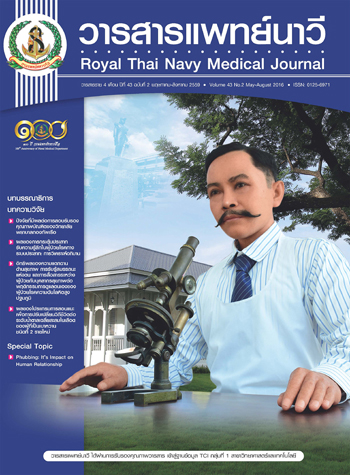ผลของโปรแกรมการสอนแนะเพื่อการปรับเปลี่ยนวิถีชีวิตต่อระดับน้ำตาลเฉลี่ยสะสมในเลือดของผู้ป่วยที่เป็นเบาหวานชนิดที่ 2 รายใหม่
Main Article Content
Abstract
This quasi-experimental research aimed to study the effects of coaching program for
lifestyle modification on HbA1c levels in newly diagnosed type 2 diabetes. The subjects
were patients with type 2 diabetes who had been diagnosed by physician within one year
prior to the study, no complications and no treatment with oral diabetes medication. The
50 samples were selected from the Medical Unit at Huachiew Hospital. The samples were
equally divided into 25 persons each in the control and experimental groups. The matched
paired design covered age, gender, level of education and HbA1c level. The control group
received routine nursing care only, but the experimental group had received the coaching
program for lifestyle modification including diet control, and exercise combined with the
process of coaching of Eaton and Johnson17 which is composed of the following: 1) Goal
definition 2) Analysis 3) Exploration for alternatives 4) Action Plan 5) Learning and 6) Feedback.
The duration time of program was conducted over a period of 12 weeks. The instrumentation
for collecting data was a demographic data form, a form for directing the testing
of newly diagnosed type 2 diabetic patients. The instrumentation was tested for reliability
with Cronbrach’s alpha coefficient at .87. The data were analyzed using frequency, percentage,
mean, and standard deviation. The hypotheses were tested using paired t- test and independent
t-test.
The results revealed the following:
1. After receiving coaching program, the mean score level of HbA1c in the experimental
group was significantly lower than before receiving coaching program at the level of .05
2. At the end of the coaching program, the mean score level of HbA1c in the experimental
group was significantly lower than the control group at the level of .05
Article Details

This work is licensed under a Creative Commons Attribution-NonCommercial-NoDerivatives 4.0 International License.
References
2. ชัชลิต รัตรสาร และคณะ. การระบาดของโรคเบาหวานและผลกระทบที่มีต่อประเทศไทย. [อินเทอร์เน็ต]. [เข้าถึงเมื่อ 10 กรกฎาคม 2559]. แหล่งที่มา: http://www.dmthai.org/sites/default/files/briefingbook_38.pdf2556.
3. สำนักระบาดวิทยา กรมควบคุมโรค กระทรวงสาธารณสุข. รายงานการเฝ้าระวังโรคไม่ติดต่อเรื้อรัง พ.ศ. 2553. [อินเทอร์เน็ต]. [เข้าถึงเมื่อ 10 กรกฎาคม 2559]. แหล่งที่มา: http://www.boe.moph.go.th/files/report/20140109_40197220.pdf.
4. ยุทธพล มั่นคง. รายงานการวิจัยเรื่องระดับน้ำตาลในเลือดที่เหมาะสมในการตรวจฮีโมโกลบินเอวันซีในผู้ป่วยเบาหวานที่เข้ารับบริการโรงพยาบาลมุกดาหาร. มุกดาหาร: โรงพยาบาลมุกดาหาร สำนักงานสาธารณสุขจังหวัดมุกดาหาร; 2554.
5. Hillier TA, Pedula KL. Characteristics of an Adult Population With Newly Diagnosed Type 2 Diabetes: The relation of obesity and age of onset. Diabetes Care 2001;24(9):1522-7.
6. Del Prato S, LaSalle J, Matthaei S, Bailey CJ. Tailoring treatment to the individual in type 2 diabetes practical guidance from the Global Partnership for Effective Diabetes Management. Int J Clin Pract 2010;64(3):295-304.
7. วิชัย เอกพลากร. รายงานการสำรวจสุขภาพประชาชนไทยโดยการตรวจร่างกาย ครั้งที่ 4 พ.ศ. 2551-2. [อินเทอร์เน็ต]. [เข้าถึงเมื่อ 12 มีนาคม 2557]. แหล่งที่มา: http://www.hiso.or.th/hiso/picture/reportHealth/nhes4.pdf 2552.
8. American Diabetes Association. Standards of medical care in diabetes--2015: summary of revisions. Diabetes Care 2015;38 Suppl 1: S4.
9. Likitmaskul S, Wacharasindhu S, Rawdaree P, Ngarmukos C, Deerochanawong C, Suwanwalaikorn S, et al. Thailand diabetes registry project: type of diabetes, glycemic control and prevalence of microvascular complications in children and adolescents with diabetes. J Med Assoc Thai 2006;89Suppl1:S10-6.
10. สินีนาฏ ลิขิตรัตน์เจริญ. การสังเคราะห์งานวิจัยเกี่ยวกับการสนับสนุนและให้ความรู้แก่ผู้ป่วยโรคเบาหวานในประเทศไทยด้วยการวิเคราะห์อภิมาน. [วิทยานิพนธ์พยาบาลศาสตรมหาบัณฑิต สาขาการพยาบาลผู้ใหญ่]. มหาวิทยาลัยมหิดล; 2543.
11. ภาวนา กีรติยุตวงศ์. การติดตามประสิทธิภาพในระยะยาวของโปรแกรมการจัดการดูแลตนเองในผู้ที่เป็นเบาหวานชนิดที่ 2. Rama Nurs J 2010;16(2):293-308.
12. Joan Everett and David Kerr. A picture of the impact of newly diagnosed type 2 diabetes. Journal of Diabetes Nursing 1998;2(6):170-5.
13. สมาคมโรคเบาหวานแห่งประเทศไทย. แนวเวชปฏิบัติสำหรับโรคเบาหวาน พ.ศ. 2557. กรุงเทพมหานคร: อรุณการพิมพ์; 2557.
14. Everett J, Kerr D. Nurse-led management of newly diagnosed type 2 diabetes. Journal of diabetes nursing 1998;2(1):12-21.
15. Thom DH, Ghorob A, Hessler D, De Vore D, Chen E, Bodenheimer TA. Impact of peer health coaching on glycemic control in low-income patients with diabetes: a randomized controlled trial. Annals of family medicine 2013;11(2):137-44.
16. Burns N, Grove SK. The practice of nursing research: conduct, critique, and utilization. St. Louis: Elsevier Saunders; 2005.
17. Eaton J, Johnson R. Coaching Successfully. London: Dorling Kindersley Books; 2001.
18. บุญใจ ศรีสถิตนรากูร. ระเบียบวิธีการวิจัยทางพยาบาลศาสตร์. กรุงเทพมหานคร: ยูแอนด์ไอ อินเตอร์มีเดีย; 2553.
19. Navicharern R, Aungsuroch Y, Thanasilp S. Effects of multifaceted nurse-coaching intervention on diabetic complications and satisfaction of persons with type 2 diabetes. J Med Assoc Thai 2009;92(8):1102-12.
20. Whittemore R, Melkus GD, Sullivan A, Grey M. A nurse-coaching intervention for women with type 2 diabetes. The Diabetes educator 2004;30(5):795-804.
21. Sahay BK, Sahay RK. Lifestyle modification in management of diabetes mellitus. J Indian Med Assoc 2002;100(3):178-80.


